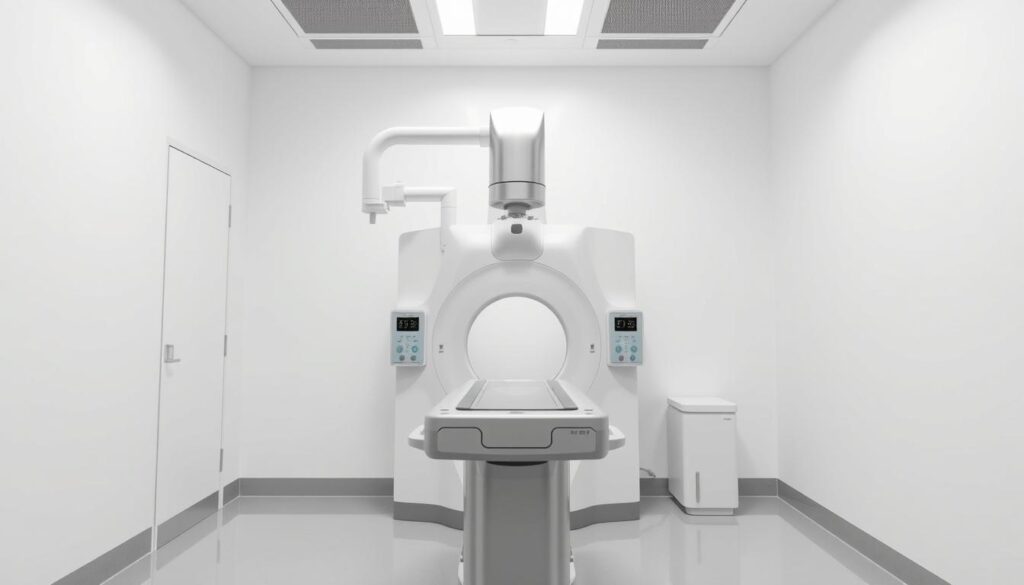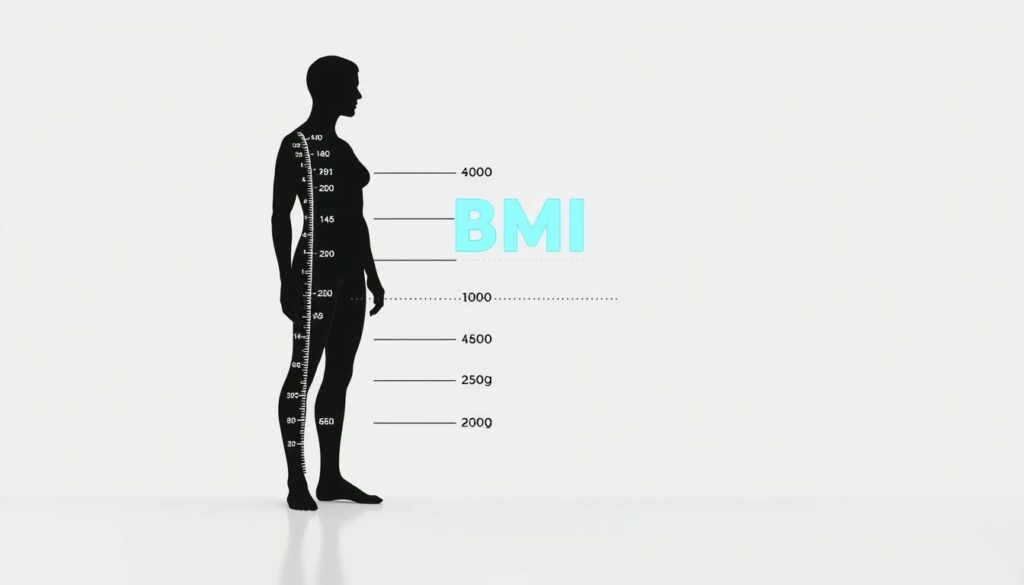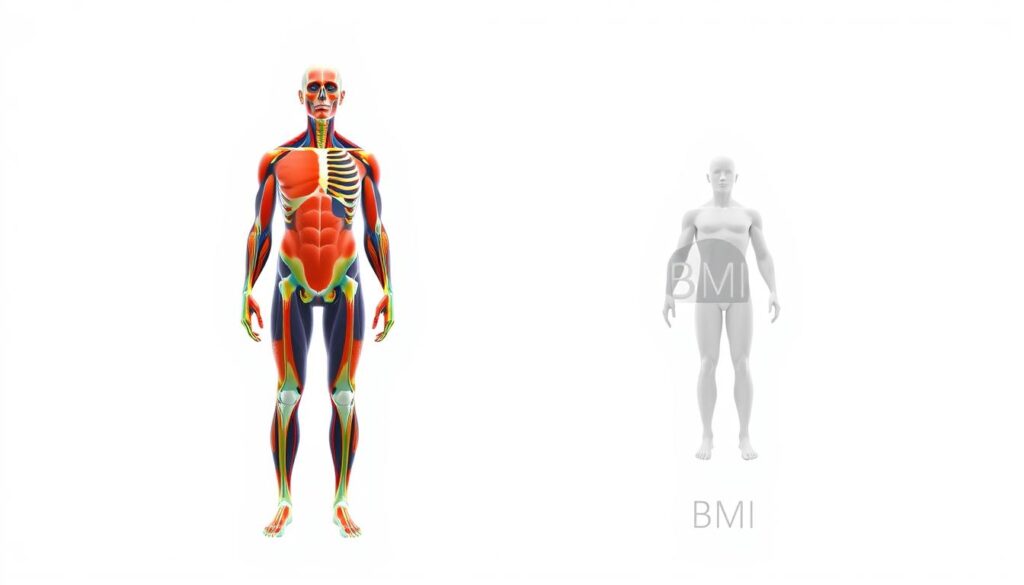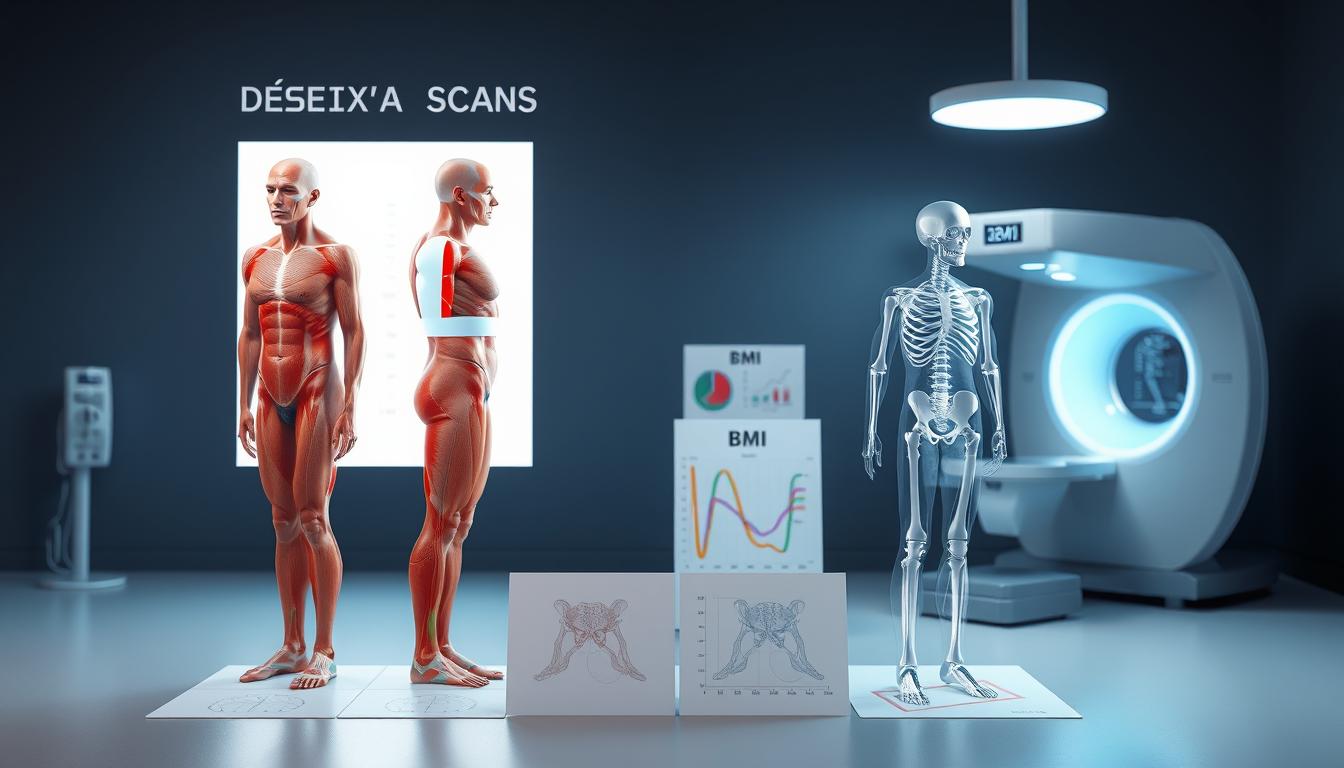When we talk about body composition, two methods stand out: DEXA scans and BMI. BMI is simple but has its limits, focusing only on height and weight. In contrast, DEXA scans give a detailed look at body composition, including fat, bone, and muscle.
We will dive into the details of body composition analysis. We’ll look at the good and bad of each method. This will help us understand them better.
Key Takeaways
- Understand the differences between DEXA scans and BMI.
- Learn how DEXA scans provide a detailed analysis of body composition.
- Discover the limitations of using BMI for body composition assessment.
- Explore the benefits of using DEXA scans for tracking changes in muscle and fat.
- Find out how DEXA scans can provide a more accurate measure of body composition.
Understanding DEXA Scans and Their Purpose
DEXA scans are a top choice for checking body composition. We’ll look into what DEXA scans are, how they work, and why they’re useful.
What is a DEXA Scan?
A DEXA scan is a non-invasive test that checks bone density and body composition. It can tell the difference between bone, lean tissue, and fat. DEXA scans are great for seeing how fat is spread and bone health, which is key for health checks.
How Does a DEXA Scan Work?
DEXA scans use low-dose X-rays to see different body tissues. They send out two X-ray beams. These beams are absorbed differently by bone and soft tissue. This way, DEXA scans can measure bone density, lean body mass, and fat mass accurately.

The scan is fast, taking less than 10 minutes. It’s also safe because it uses low radiation. For more on DEXA scans versus BMI, check out our article on BMI vs DEXA Scan.
Benefits of a DEXA Scan
DEXA scans have many benefits:
- Detailed Body Composition Analysis: They give a detailed look at body composition, including fat and lean mass.
- Bone Density Measurement: They accurately measure bone density, which is key for spotting osteoporosis.
- Health Risk Assessment: By looking at fat distribution, DEXA scans help spot health risks.
| Feature | Description | Benefit |
|---|---|---|
| Body Composition Analysis | Detailed breakdown of fat and lean mass | Understands health risks associated with fat distribution |
| Bone Density Measurement | Accurate measurement of bone density | Diagnoses osteoporosis and assesses fracture risk |
| Low Radiation Exposure | Safe due to low-dose X-rays | Minimizes health risks associated with radiation |
In conclusion, DEXA scans are a powerful tool for body composition analysis. They offer detailed and accurate insights. By understanding DEXA scans and their benefits, people can make better health and fitness choices.
Understanding Body Mass Index (BMI)
BMI is simple yet has deep implications. It’s a tool for checking weight status and health risks. It helps sort people into weight categories easily.
What is BMI?
BMI is a number based on weight and height. It shows body fatness and health risks. BMI is calculated with a simple formula, making it easy to use.
How is BMI Calculated?
To find BMI, divide weight in kilograms by height in meters squared (kg/m2). For example, a 70 kg person who is 1.75 meters tall has a BMI of 22.86. This number helps sort people into weight groups.

The World Health Organization (WHO) sets BMI categories. These include underweight, normal, overweight, and obese. Doctors use these to assess health risks and offer weight advice.
Limitations of BMI
BMI has limitations. It doesn’t tell the difference between muscle and fat. This can misclassify athletes or those with a lot of muscle as overweight or obese.
Also, BMI doesn’t look at where fat is stored. Visceral fat, around the belly, is risky but BMI can’t spot it.
- BMI doesn’t tell muscle from fat.
- It ignores where fat is stored.
- BMI might not work for non-European body types.
Knowing these limits helps understand BMI better. It’s key for making smart health and weight choices.
Key Differences Between DEXA Scans and BMI
Understanding the differences between DEXA scans and BMI is key. Both help measure body composition but in different ways. They give different insights into our health.
Accuracy and Precision
BMI and DEXA scans differ in accuracy. BMI uses a simple formula that doesn’t separate lean body mass from fat. This can lead to wrong classifications.
DEXA scans, on the other hand, measure bone density, fat, and lean mass directly. They give a clearer view of body composition.
For example, athletes with lots of muscle might have a high BMI without being overweight. This shows BMI’s limitations in health assessments.
Measurement of Body Composition
DEXA scans break down body composition into bone density, fat, and lean mass. This detailed info is crucial for health risk assessment.
BMI, though, just tells if a person’s weight is healthy for their height. It doesn’t tell the difference between fat and muscle.
| Characteristics | DEXA Scan | BMI |
|---|---|---|
| Measures | Bone density, fat mass, lean mass | Weight in relation to height |
| Accuracy | High | Limited |
| Clinical Use | Detailed health assessments | General health screening |
Clinical Relevance
DEXA scans and BMI have different uses in healthcare. DEXA scans help diagnose conditions like osteoporosis and track body composition changes.
“DEXA scans provide a nuanced understanding of body composition, which is critical for assessing health risks and developing targeted interventions.”
BMI is good for initial screenings but lacks detail. Its simplicity makes it useful for big health assessments.

Advantages of Using DEXA Scans
DEXA scans offer many benefits, like precise body composition analysis and health risk assessment. They are great for those wanting a full health check.
Detailed Insights into Health
DEXA scans give detailed insights into an individual’s health. They measure bone density and body composition, including fat and lean mass. This info is key for understanding health and spotting risks early.
For example, a DEXA scan can spot osteoporosis by checking bone density. It also looks at muscle and fat distribution, giving a full body composition picture.
- Assesses bone density to diagnose osteoporosis
- Measures fat mass and lean mass for a comprehensive body composition analysis
- Helps in identifying health risks associated with abnormal body composition
Assessment of Fat Distribution
DEXA scans are great at checking fat distribution. They look at visceral fat, which is linked to heart disease and diabetes.
Knowing where fat is in the body helps people take steps to lower health risks. For instance, too much visceral fat might mean it’s time for lifestyle changes.
Long-term Health Monitoring
DEXA scans are not just for one-time checks; they’re also for long-term health monitoring. They let people and doctors track body composition and bone density changes over time. This helps see if treatments are working.
This is really helpful for people with conditions like osteoporosis or those trying to manage their weight.
- Monitor changes in body composition over time
- Track the effectiveness of treatments for conditions like osteoporosis
- Adjust health and fitness programs based on detailed body composition data
Limitations of DEXA Scans
DEXA scans are great for checking body composition, but they have some limits. It’s important to know these to fully understand their use.
Cost and Accessibility
One big issue with DEXA scans is their cost and how hard they are to get. They can be pricey, and insurance might not cover them. Also, not everyone has access to DEXA scanners, mainly in rural areas.
To solve these problems, some doctors are looking at cheaper, easier ways to check body composition. For example, bioelectrical impedance analysis (BIA) devices are getting more popular. They’re cheaper and easier to find, but they’re not as precise as DEXA scans.
| Method | Cost | Accessibility | Precision |
|---|---|---|---|
| DEXA Scan | High | Limited | High |
| BIA | Low-Moderate | High | Moderate |
| Hydrostatic Weighing | Moderate | Limited | High |
Radiation Exposure
DEXA scans also involve some radiation, which is a concern. The amounts are safe, but it’s something to think about, mainly for people getting scanned often.
Newer DEXA scan tech tries to use less radiation without losing image quality. Doctors also follow strict rules to make sure the scan’s benefits are worth the radiation risk.
Interpretation of Results
Getting DEXA scan results right needs special training. If not done right, it can lead to wrong conclusions about health or body shape.
Doctors need good training to understand DEXA scan results. It’s also important to look at the whole picture, including the person’s health history and other tests.
Advantages of Using BMI
BMI is easy to use and understand. It only needs your weight and height to calculate. This makes it useful for both doctors and people checking their health at home.
Easy to Calculate
Calculating BMI is simple. The formula is straightforward: BMI = weight (in kg) / height (in meters) squared. You just need a scale and a measuring tape to figure it out.
Quick Screening Tool
BMI is a fast way to check your weight status. It shows if your weight is healthy for your height. This helps spot health risks early, which is great in doctor’s offices.
Widely Accepted
BMI is used everywhere. It’s simple and health groups all over recommend it. This makes BMI a common way for doctors to talk about weight.
A health expert said,
“BMI is a useful initial screening tool because of its simplicity and the ease with which it can be calculated.”
Many health groups agree. They say BMI is a good first step to check weight-related health risks.
In summary, BMI is good because it’s easy to use, quick, and accepted worldwide. These points make BMI a helpful tool for checking weight status, even with its downsides.
Limitations of BMI
BMI is widely used but has many limitations. It doesn’t tell the difference between body fat and lean body mass. This can lead to wrong health assessments, mainly for athletes or those with a lot of muscle.
Fails to Distinguish Between Fat and Muscle
BMI uses weight and height to calculate body mass index. It doesn’t look at what makes up the body. So, athletes with a lot of muscle might have a high BMI without being overweight.
For example, a professional football player might be seen as overweight or obese by BMI. Yet, they might have a low body fat percentage. This can cause unnecessary worry and bad health advice.
Influenced by Age and Gender
BMI also changes with age and gender, making it less accurate. Older adults tend to have more body fat for the same BMI than younger people. This is because they lose muscle and bone density with age.
- Older adults may have a higher body fat percentage at the same BMI.
- Women generally have a higher percentage of body fat compared to men at the same BMI.
This shows we need a better way to check health. One that looks at age, gender, and body type.
Risk of Misclassification
There’s a big risk of getting health wrong with just BMI. People might be seen as healthy when they’re not, or vice versa. This can really affect health care and treatment.
- People with a lot of muscle might be seen as overweight.
- The elderly might be seen as healthy when they’re not.
Knowing these issues is key for doctors and patients. It helps us make better health choices and assessments.
Conclusion: Choosing Between DEXA Scan and BMI
Choosing between DEXA scans and BMI depends on how detailed you need your health assessment to be. We’ve looked at what each method offers and their uses.
Detailed Body Composition Analysis
DEXA scans give a detailed look at body fat, muscle, and bone density. They’re perfect for athletes or those with health concerns. This detailed analysis helps create personalized fitness and health plans.
Simple Health Assessments
BMI is a quick way to check if your weight is healthy. It’s simple to use and gives a basic idea of your health status. But, it has its own set of limitations.
Evolving Health Metrics
Health metrics are changing, with DEXA scans leading the way. Knowing the difference between DEXA scans and BMI helps pick the right tool. This leads to better health outcomes for everyone.


